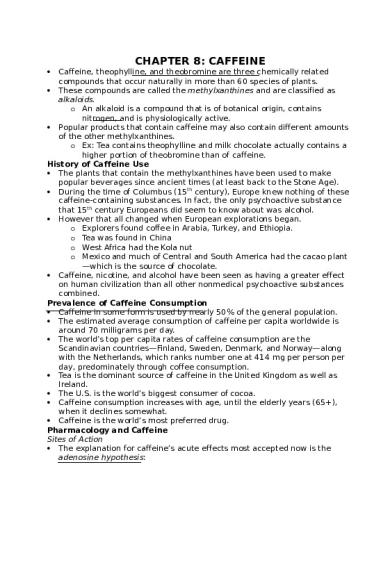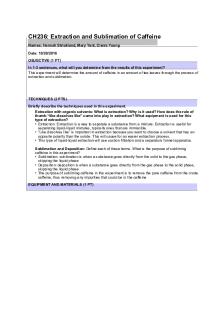Caffeine History And Use PDF

| Title | Caffeine History And Use |
|---|---|
| Course | Drugs And Behavior |
| Institution | Binghamton University |
| Pages | 4 |
| File Size | 94 KB |
| File Type | |
| Total Downloads | 98 |
| Total Views | 145 |
Summary
Caffeine History And Use...
Description
CHAPTER 8: CAFFEINE Caffeine, theophylline, and theobromine are three chemically related compounds that occur naturally in more than 60 species of plants. These compounds are called the methylxanthines and are classified as alkaloids. o An alkaloid is a compound that is of botanical origin, contains nitrogen, and is physiologically active. Popular products that contain caffeine may also contain different amounts of the other methylxanthines. o Ex: Tea contains theophylline and milk chocolate actually contains a higher portion of theobromine than of caffeine. History of Caffeine Use The plants that contain the methylxanthines have been used to make popular beverages since ancient times (at least back to the Stone Age). During the time of Columbus (15th century), Europe knew nothing of these caffeine-containing substances. In fact, the only psychoactive substance that 15th century Europeans did seem to know about was alcohol. However that all changed when European explorations began. o Explorers found coffee in Arabia, Turkey, and Ethiopia. o Tea was found in China o West Africa had the Kola nut o Mexico and much of Central and South America had the cacao plant —which is the source of chocolate. Caffeine, nicotine, and alcohol have been seen as having a greater effect on human civilization than all other nonmedical psychoactive substances combined. Prevalence of Caffeine Consumption Caffeine in some form is used by nearly 50% of the general population. The estimated average consumption of caffeine per capita worldwide is around 70 milligrams per day. The world’s top per capita rates of caffeine consumption are the Scandinavian countries—Finland, Sweden, Denmark, and Norway—along with the Netherlands, which ranks number one at 414 mg per person per day, predominately through coffee consumption. Tea is the dominant source of caffeine in the United Kingdom as well as Ireland. The U.S. is the world’s biggest consumer of cocoa. Caffeine consumption increases with age, until the elderly years (65+), when it declines somewhat. Caffeine is the world’s most preferred drug. Pharmacology and Caffeine Sites of Action The explanation for caffeine’s acute effects most accepted now is the adenosine hypothesis:
o Adenosine is a chemical that the body produces; it is an inhibitory neurotransmitter. o Adenosine leads to behavioral sedation, regulation of oxygen delivery to cells, dilation of cerebral and coronary blood vessels, and production of asthma. o Caffeine and the other methylxanthines occupy adenosine receptors and then block the action of that transmitter. Pharmacokinetics Absorption o Caffeine is rapidly absorbed from the gastrointestinal tract. o The drug quickly reaches the brain because it can pass through the blood-brain barrier. o The half-life of caffeine in the blood varies widely among people and ranges from about 3-7 hours. o Peak levels of caffeine occur 15-45 minutes after the drug is taken and sometimes depend on the source. Distribution o Caffeine is equally distributed in total body water. Therefore, after consumption, the concentration of caffeine is similar throughout the body. Metabolism and Excretion o The liver does most of the metabolizing of caffeine. The drug is excreted almost entirely by the kidneys. o Very small proportions of caffeine are also excreted in feces, saliva, semen, and breast milk. Tolerance and Dependence Caffeine Withdrawal The caffeine withdrawal symptoms most consistently reported are headache and fatigue. Symptoms of caffeine abstinence can also include depression, decreased alertness, less contentment and relaxed mood, decreased activity and energy, greater sleepiness and drowsiness, and increased irritability. Physical dependence can develop with an exposure of 300 mg of caffeine a day for only three consecutive days. Tolerance In general, tolerance probably does develop to caffeine’s effects on renal function, sleep, and other physiological functions, such as blood pressure and heart rate. On the other hand, little tolerance seems to develop to caffeine’s stimulant effects. Acute Effects of Caffeine Behavioral and Psychological Effects Mood o The CNS-stimulation action of caffeine elevates mood.
o Moderate doses of caffeine are reliably associated with feeling energized, creative, efficient, confident and alert. Performance o One of the major ways caffeine improves task performance is by decreasing fatigue and increasing vigilance so that, over time, performance does not drop below what is typical for a person. o Caffeine’s effects depend not only on the drug’s pharmacological action but also on the dose of the drug, the setting in which it is used, and the personality of the user. o Finally, there is evidence that caffeine enhances athletic performance, including perceived exertion and endurance. Interactions among Caffeine, nicotine, and Alcohol (using them in combination) Smokers smoke fewer cigarettes after they drink coffee compared with when they have not had coffee One study suggests that everyday forgetfulness has something to do with the state-dependent effects of caffeine, nicotine and alcohol in combination. Acute Toxic Effects of Caffeine Caffeinism or caffeine intoxication: toxic effects that occur from consuming too much caffeine. o Symptoms include lightheadedness, tremulousness, breathlessness, headache, and irregular heartbeat. o Consuming more than 1,000 mg of caffeine a day increases the risk of experiencing even more severe toxic symptoms, including muscle twitching, rambling flow of thought and speech, cardiac arrhythmia, periods of inexhaustibility, and psychomotor agitation. o The lethal dose of caffeine when it is taken orally is about 10 grams for adults (about 75 cups of coffee) and 100 mg for children. Chronic Effects of Caffeine Use Moderate doses of caffeine do not have negative effects on reproduction, although high levels of caffeine intake among women attempting to become pregnant can e associated with lower rates of conception. Research with postmenopausal women has indicated a positive relationship between the lifetime amount of caffeinated coffee consumed and osteoporosis. Caffeine ingestion can lead to indigestion, palpitations, tremor, headache, and insomnia. Frequent coffee drinkers have a lower risk of dying from a variety of diseases, relative to people who drink little or no coffee. o For example, the more coffee consumed, the less likely the person was to die from a range of healthy problems, such as diabetes, heart disease, respiratory disease, stroke, and infections.
o Coffee consumption may help prevent several chronic diseases, including liver disease, Parkinson’s disease, and type 2 diabetes mellitus. o There are also some indications that caffeine may provide some protections to the development of Alzheimer’s disease. In summary, caffeine is considered a relatively safe drug. Therapeutic Uses of Caffeine Caffeine is very much a part of the medications used to treat a range of ailments. In fact, other methylxanthines also have therapeutic value. Caffeine is the most common drug, as it is part of many remedies for headaches and colds. Its mild stimulant properties help to counteract some of the side effects of medications for those ailments. Caffeine also is in appetite-suppressant medications because of its diuretic effects. -------------------------------------------------------------------------------------------------------------------------SUMMARY Caffeine and other methylxanthines drugs occur naturally in more than 60 species of plants. Caffeine is the world’s most popular drug, and humans have used it since ancient times. Many everyday products that children or adults consume contain caffeine. Overall, coffee is the major source of caffeine, but tea is the dominant source for many countries. In the last 30 years, soft drinks and energy drinks have emerged as other significant sources of caffeine. Total caffeine consumption does not seem to vary by characteristics of people, except for age. When we factor in body weight, children aged 1-5 have the highest exposure to caffeine, after adults aged 18+ Caffeine’s mechanism of action seems to be blocking of adenosine receptor sties. Caffeine is rapidly absorbed from the gastrointestinal tract and is distributed throughout the body. Its half-life in the blood ranges from 2.57.5 hours. Caffeine is metabolized primarily in the liver and is almost entirely excreted in the urine. A clear withdrawal syndrome has been identified for caffeine, and there is evidence for the development of tolerance to some of caffeine’s effects. The acute effects of caffeine include diuresis, stimulation of the heart and CNS, relaxation of smooth muscles, and stimulation of gastric acid. Because many people use caffeine, nicotine, and alcohol in some combination, knowing how each of these drugs interacts with the other two is important. Acute caffeine intoxication is called caffeinism. Caffeinism is most likely to occur with a dose of 600 mg or higher. The higher the dose of caffeine, the more severe the symptoms. Overall, caffeine is a relatively safe drug, but important research questions remain about long-term caffeine use and health....
Similar Free PDFs

Caffeine History And Use
- 4 Pages

Caffeine and jump height (V1)
- 12 Pages

Caffeine speech
- 5 Pages

Caffeine Lab Report
- 3 Pages

UV-Vis Spectroscopy Caffeine
- 10 Pages

Caffeine Lab Report
- 4 Pages

Lab 1: Isolating Caffeine
- 8 Pages

Paper Marine and land use
- 11 Pages

Sundials Design, Construction, and Use
- 196 Pages
Popular Institutions
- Tinajero National High School - Annex
- Politeknik Caltex Riau
- Yokohama City University
- SGT University
- University of Al-Qadisiyah
- Divine Word College of Vigan
- Techniek College Rotterdam
- Universidade de Santiago
- Universiti Teknologi MARA Cawangan Johor Kampus Pasir Gudang
- Poltekkes Kemenkes Yogyakarta
- Baguio City National High School
- Colegio san marcos
- preparatoria uno
- Centro de Bachillerato Tecnológico Industrial y de Servicios No. 107
- Dalian Maritime University
- Quang Trung Secondary School
- Colegio Tecnológico en Informática
- Corporación Regional de Educación Superior
- Grupo CEDVA
- Dar Al Uloom University
- Centro de Estudios Preuniversitarios de la Universidad Nacional de Ingeniería
- 上智大学
- Aakash International School, Nuna Majara
- San Felipe Neri Catholic School
- Kang Chiao International School - New Taipei City
- Misamis Occidental National High School
- Institución Educativa Escuela Normal Juan Ladrilleros
- Kolehiyo ng Pantukan
- Batanes State College
- Instituto Continental
- Sekolah Menengah Kejuruan Kesehatan Kaltara (Tarakan)
- Colegio de La Inmaculada Concepcion - Cebu






